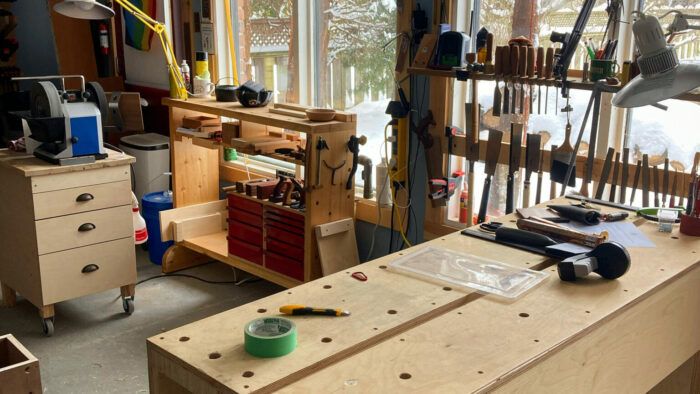I’ve observed (and participated in) a strange phenomenon that occurs in many woodshops. I call it perpetual shop tweaking. My non-woodworker partner Andrea commented the other day as I was fussing yet again with my shop scale drawing, “You never seem happy with your shop layout. Why is that”?
That’s a good question. I posted the question on the VTW social media channels to see what other woodworkers thought. It seems that many woodworkers can relate. They simply enjoy tweaking and twiddling their shop space. The reasons ranged from “got a new tool and need to make it fit” to “always trying to make more space” to “reconfiguring to work on different types of projects.”
In my case it’s usually about two things: being comfortable in my space and improving workflow. Combined, these two things help to improve my efficiency. When I set up this shop back in the summer of 2020, it needed to happen quickly. I make my living teaching, writing, and creating visual content about woodworking so the shop had to get up and running as quickly as possible. I had some time to think about the shop layout prior to moving things in, but those are merely theoretical thoughts. You don’t really know until you get in there and start woodworking.
I wrote a blog about the way I did the theoretical work, which you can check out here. After a few days, I made some tweaks to the layout because some machines were too close to each other or interfered with infeed and outfeed areas. Since then, there haven’t been huge changes to the shop other than little adjustments here or there.
I have realized that a big part of my comfort and efficiency in the shop comes from having the tools I use most close at hand. So this means that I need to make more changes. I also spend a lot of time teaching private students online so the space also needs to be conducive to other equipment, such as cameras and lighting. And I need to be able to pack all that equipment away so that I can do in-person teaching and, oh yeah, actual woodworking.
My latest turmoil surrounds the tablesaw. I didn’t have a tablesaw for about 10 years because I never had room for one and I had used other tools to do what the tablesaw can do. Between a track saw and router, I could do without the tablesaw. Shortly after I moved into this shop, my good friend upgraded his tablesaw and gave me his old one. I’ve since found it useful for joinery work but I don’t use it for stock prep, which means I don’t need 30-something inches of rip or lots of in- and out-feed space.
So at night when I’m falling asleep, the questions start to swirl:
Should I keep the tablesaw?
If I keep it should I reduce its footprint?
What if I cut the rails shorter? How short?
What if I cut the rails short and still don’t like it?
These are some of the things that woodworkers toil over that a non-woodworker couldn’t possibly understand. Andrea’s solution is simple: “Get rid of the tablesaw! You did fine without it before, which means you don’t need it.” But you and I know that it’s more complicated than this. It was free; how do you say no to a free tool? Also, there are so many things to try before parting ways with it. Many woodworkers I know say the questioning and tweaking will never end, and I tend to agree. Plus, if you factor in this magazine that we all know and love being full of great new techniques or tools to try out, you’re in trouble.
Are you 100% satisfied with your workspace or are you a serial tweaker?
More by Vic Tesolin








